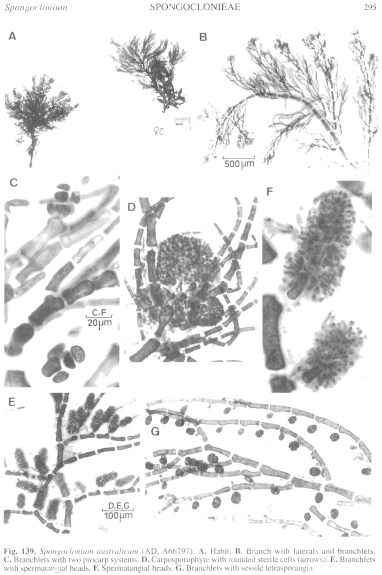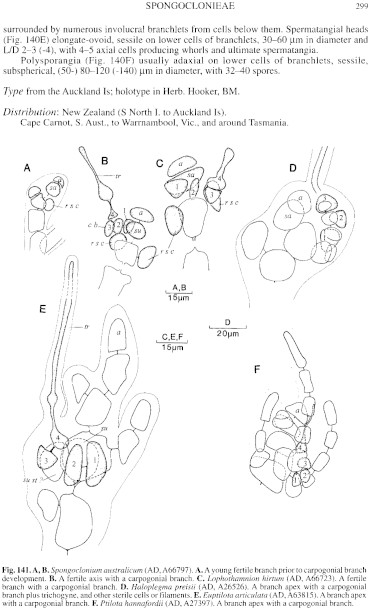|
|
|
|
|
|||||||||||
|
Electronic Flora of South Australia Species Fact Sheet
Phylum Rhodophyta – Order Ceramiales – Family Ceramiaceae – Tribe Spongoclonieae
Thallus (Fig. 139A) erect, flaccid, red-brown to grey-red, 1–8 (–12) cm high, much branched with slender axes and irregular laterals (Fig. 139B), older axes often loosely corticated with rhizoids. Holdfast small, rhizoidal, 2–5 mm in diameter; epilithic or epiphytic on seagrasses or various algae. Structure. Axis radially branched, apices inconspicuous, each axial cell with a single more or less determinate lateral branchlet. Axial cells 20–40 µm in diameter and L/D 2–4 near apices, increasing to 150–300 µm in diameter and L/D (1–) 2–4 (–5) near the base; lateral branchlets 0.4–1 mm long (some developing as indeterminate laterals), basal cells 25–40 µm in diameter and L/D (2–) 3–4, decreasing gradually to 10–15 m in diameter and L/D 2.5–5 (–8) in subterminal cells. Corticating rhizoids relatively few, descending from basal cells of lateral branchlets, slender, 10–20 µm in diameter with long cells. Cells multinucleate; rhodoplasts discoid to elongate and branched, becoming ribbon-like in larger cells.
Reproduction: Gametophytes dioecious. Procarps (Figs 139C, 141A, B) borne on short special lateral branches on upper branches, 3 cells long with the subapical cell bearing directly a 4-celled carpogonial branch and the third cell bearing two opposite periaxial cells which remain undivided; the 3 sterile cells (apical and periaxial) enlarge and become rounded (Fig. 139D). Post-fertilization the auxiliary cell is apparently cut off the subterminal (supporting) cell and 3–4 successive rounded gonimolobes 200–450 µm across are produced, each with all cells becoming ovoid-angular carposporangia 10–22 µm in diameter; curved involucral branchlets arise from the axial cell below the female branchlet. Spermatangial heads (Fig. 138E, F) usually adaxial on cells of branchlets, 25–45 µm in diameter and L/D 1.5–2.5, sessile, with 3–4 axial cells each cutting off several cells producing spermatangial initials and ovoid spermatangia 1.5–2.5 µm in diameter.
Tetrasporangia (Fig. 139G) borne on successive cells of branchlets, usually adaxially, sessile, subspherical to ovoid, 25–45 µm in diameter, tetrahedrally divided, occasionally further divided (to octosporangia).
Type from Muston, American R. inlet, Kangaroo I., S. Aust., 3 m deep on Heterozostera (J. Lavers, 7.ix.1996); holotype in AD, A66797.
Selected specimens: Coffin Bay, S. Aust., 1–2 m deep (P. Womersley, 1.xii.1975; AD, A46792). N Spencer Gulf, S. Aust., 9 m deep (Shepherd, 13.ix.1973; AD, A44192). Tiparra reef, S. Aust., 10–12 m deep (Shepherd, 16.iii.1985; AD, A55690). Off St Kilda, S. Aust.. on Heterozostera, 2.5 m deep (S. Lewis, 4.ix.1972; AD, A42746). Grange, S. Aust., 20 m deep on artificial reef (Branden, 4.ix.1985; AD, A56770). American R. inlet,
Distribution: Coffin Bay, S. Aust., to Crawfish Rock, Westernport Bay, Victoria.
Taxonomic notes: Kangaroo I., S. Aust., 3–4 m deep near entrance (Kraft, 18.i.1974; AD, A45069). Crawfish Rock, Westernport Bay, Vic., 8 m deep (Watson, 28.v.1974; AD, A45442).
This lightly corticated species might be placed in the genus Mesothamnion Børgesen, but as noted above there are no reproductive differences between this genus and Spongoclonium, which is here considered to include Mesothamnion. It differs from the type species, M. caribaeum Børgesen (1917, p. 208, figs 194–200) in being a larger plant, more corticated, and having generally longer axial cells.
References:
BØRGESEN, F. (1917). The marine algae of the Danish West Indies. Vol. 2. Rhodophyceae. Part 3. Dansk. bot. Ark. 3, 145–240.
The Marine Benthic Flora of Southern Australia Part IIIC complete list of references.
Publication:
Womersley, H.B.S. (24 December, 1998)
The Marine Benthic Flora of Southern Australia
Rhodophyta. Part IIIC. Ceramiales – Ceramiaceae, Dasyaceae
©State Herbarium of South Australia, Government of South Australia
Illustrations in Womersley Part IIIA, 1998: FIGS 139, 141A, B.

Figure 139 enlarge
Fig. 139. Spongoclonium australicum (AD, A66797). A. Habit. B. Branch with laterals and branchlets. C. Branchlets with two procarp systems. D. Carposporophyte with rounded sterile cells (arrows). E. Branchlets with spermatangial heads. F. Spermatangial heads. G. Branch lets with sessile tetrasporangia.

Figure 141 enlarge
Fig. 141. A, B. Spongoclonium australicum (AD, A66797). A. A young fertile branch prior to carpogonial branch development. B. A fertile axis with a carpogonial branch. C. Lophothamnion hirtum (AD, A66723). A fertile branch with a carpogonial branch. D. Haloplegma preisii (AD, A26526). A branch apex with a carpogonial branch plus trichogyne, and other sterile cel Is or filaments. E. Euptilota articulata (AD, A63815). A branch apex with a carpogonial branch. F. Ptilota hannafordii (AD, A27397). A branch apex with a carpogonial branch.

|
Email Contact: State Herbarium of South Australia |

|